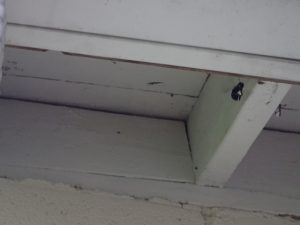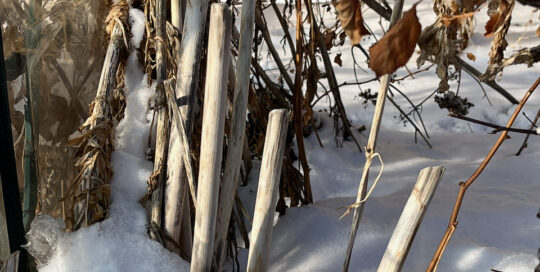Listening to the hum of the carpenter bees
Views: 1063

We were standing near my sister’s garage the other evening. There were at least 8 carpenter bees (although I didn’t know at first that’s what they were). They were seemingly attempting to burrow into the eaves of her garage where some of the paint wore off over the years. Earlier that day while sitting on the deck, I noticed another huge – what I thought was a bumble bee – try to bore into the wood of the railing. I figured I was mistaken.
Growing up in Ohio, I always thought the big bees flying in and out of the eaves of the house or barn were bumble bees. But after noticing a number of them during a trip back to visit family, I realized it was a far different creature. Although they are resemble bumble bees with their fuzzy, black and yellow bodies, what I saw were carpenter bees, a totally different creature. One of the most visible physical differences is the carpenter bees have sleek, black abdomens versus the fuzzy one on bumbles. And on the scientific level, carpenter bees are of the Xylocopa genus, while bumble bees are of Bombus. Both are important pollinators to have in the garden.
Carpenter Bees
Carpenter bees are solitary bees more like the mason bees instead of the bumble bees who form nests, so they’re not apt to sting. (The females can, but rarely do. You practically have to squeeze them.) On the other hand, bumble bees build nests in the ground. They will defend their territory if you are too close or harass them in any way.
Yet, even with their docile demeanor the carpenter bees still can be intimidating. They bomb your head or hover very closely. And when you hear a group of them together looking for somewhere to build a nest, it really catches your attention. I likened the low hum it to a group of bombers in WWII.
While the carpenter bees are not aggressive, they’re problematic. They bore nearly 1/2 inch wide and 6-10 inch deep chambers into unpainted or untreated surfaces with their mandibles. This is an amazing feat as they chew out a bite at a time. In the spring, the young adult bees are cleaning out or creating the tunnels in which to supply a food source called bee bread, and a place to lay an egg in each chamber before sealing it off. While I only saw the bees removing bits of wood, my stepmother said that when the carpenter bees nested in the eaves of the rabbit cages, she often saw them bring single strands of rabbit hair into their tunnels. That would make for a cozy nest.
A female makes 6-8 tunnels each season. The eggs hatch in the chamber, then continue development until they emerge as adults in early August. They will come out to feed on nectar and spend the winter back in their cozy tunnel.
Removing Carpenter Bees
If the carpenter bees are damaging your eaves or furniture, they are fairly easy to dispatch. You can use a wasp or hornet spray, or you can dust or spray the holes with diatomaceous earth, borax, or carbaryl. That would have to be done at night when the bees aren’t at home. Be sure to wear gloves, a mask and goggles in case it drifts onto your face. And in some situations, it’s just not worth climbing a high ladder to reach the bees. It’s wise to call in a professional in that situation.
But if they are not actively hurting anything, let them do their thing. They’ll also nest in the stems of large, pithy plants, and old trees. So, keep that in mind when you’re assessing your landscape situation. If you leave these items for the carpenter bees, they might ignore your eaves while still pollinating your plants.
Meet Amy Grisak
Amy is a freelance author and photographer in Great Falls, MT who specializes in gardening, foods, and sustainable agriculture. She provides information on every kind…
Amy's Recent Posts

This Little Piggy is a Problem: Dealing with Feral Hogs








